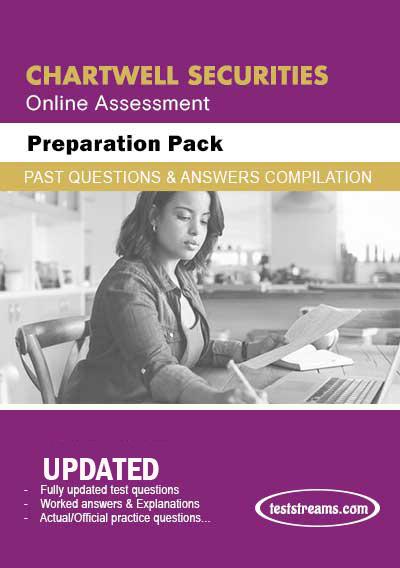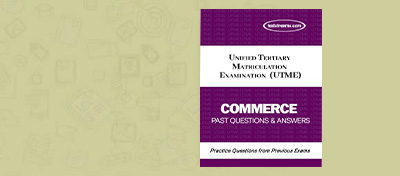Chartwell Securities Aptitude Test Past Questions and Answers- 2023 [Free PDF Download]
In the competitive world of finance and investment, landing a job at a prestigious firm like Chartwell Securities is a coveted achievement. Aspiring candidates often face a rigorous selection process, and one crucial step on this journey is the aptitude test. To help you prepare effectively, we’ve compiled a comprehensive guide to the Chartwell Securities aptitude test, complete with past questions and answers to give you the edge you need to succeed.
Why the Chartwell Securities Aptitude Test?
The Chartwell Securities aptitude test is a key component of their recruitment process. It serves as a tool to assess candidates’ cognitive abilities, problem-solving skills, numerical reasoning, and critical thinking. By evaluating these attributes, Chartwell Securities aims to identify individuals who possess the analytical prowess required to excel in the dynamic world of finance.
About Chartwell Securities
Chartwell Securities Limited was incorporated on March 30, 2007 and obtained its Dealing License from the Nigerian Stock Exchange on 18th April 2007. The Company was registered by the Securities and Exchange Commission in January 2008 as a Broker/Dealer firm to operate in the Nigerian Capital market. The Company was also registered by the Securities and Exchange Commission as an Issuing House to render Issuing House and Financial Advisory services in July 2012. The Board and Executive Management of the Company comprises of distinguished individuals who are vastly experienced in the financial services industry in both the money and the capital market segments. thus positioning the company in good stead to deliver quality services to its clients.
What to expect on Chartwell Securities Online Test.
Numerical Reasoning: This section evaluates your ability to work with numbers, interpret data, and perform calculations. You might encounter questions related to percentages, ratios, currency conversions, and financial calculations. The questions will test your quantitative skills and ability to analyze numerical information.
Verbal Reasoning: In this section, you’ll be presented with passages of text and asked questions to assess your comprehension, critical thinking, and ability to draw conclusions from written information. This section is designed to evaluate your communication and analytical skills.
Critical Thinking: Critical thinking questions assess your ability to analyze complex situations, identify patterns, and make logical decisions. These questions often require you to think
Tips for Success:
Practice Past Questions: Familiarize yourself with the types of questions you might encounter by practicing past questions and sample tests. This will help you become comfortable with the test format and improve your speed and accuracy.
Brush Up on Financial Concepts: Review key financial concepts, terminology, and calculations relevant to the position you’re applying for.
Read Carefully: Pay close attention to instructions and questions. Reading comprehension is vital, and misunderstanding a question could lead to incorrect answers.
Manage Your Time: Allocate time wisely to each section based on the number of questions and the difficulty level. Don’t get stuck on a single question; if you’re unsure, move on and come back if time permits.
Stay Calm: The online test can be challenging, but staying calm and focused will help you perform at your best. Take deep breaths, manage your stress, and approach each question with confidence.
Sample Questions on Chartwell Securities Online Aptitude Test
NUMERICAL REASONING
Question 1:
A stock’s value increased by 20% in the first quarter and then decreased by 10% in the second quarter. What is the overall percentage change in the stock’s value over the two quarters?
A) 8%
B) 10%
C) 12%
D) 9%
Answer: B) 10%
Explanation: To calculate the overall percentage change, we use the formula: ((Final Value – Initial Value) / Initial Value) * 100. In this case, the overall percentage change is ((20 – 10) / 20) * 100 = 10%.
Question 2:
If an investment of $5,000 grows at a compound interest rate of 6% per annum for 4 years, what is the final amount?
A) $6,585.36
B) $6,745.32
C) $6,904.56
D) $6,257.98
Answer: A) $6,585.36
Explanation: The formula for compound interest is: Final Amount = Principal * (1 + Rate/100)^Time. Plugging in the values, Final Amount = 5000 * (1 + 6/100)^4 = $6,585.36.
Question 3:
A company’s revenue increased by 15% in Year 1, then by 10% in Year 2, and then decreased by 5% in Year 3. What is the overall percentage change in revenue over the three years?
A) 19.5%
B) 20.5%
C) 18.5%
D) 21%
Answer: A) 19.5%
Explanation: Using the formula as before, the overall percentage change is ((15 + 10 – 5) / 15) * 100 = 19.5%.
Question 4:
If the exchange rate between USD and EUR is 1 USD = 0.85 EUR, how much is 500 USD in EUR?
A) 450 EUR
B) 425 EUR
C) 510 EUR
D) 575 EUR
Answer: B) 425 EUR
Explanation: Multiply the amount in USD by the exchange rate: 500 USD * 0.85 EUR/USD = 425 EUR.
Question 5:
A company’s profit margin is 15%. If its revenue is $1,200,000, what is its profit?
A) $180,000
B) $120,000
C) $150,000
D) $200,000
Answer: A) $180,000
Explanation: Profit = Revenue * Profit Margin = $1,200,000 * 0.15 = $180,000.
Question 6:
If the market index increased by 5% on Monday and then decreased by 3% on Tuesday, what is the net percentage change in the index’s value over the two days?
A) 1.85%
B) 2.40%
C) 1.50%
D) 1.95%
Answer: A) 1.85%
Explanation: The net percentage change is ((5 – 3) / 5) * 100 = 1.85%.
Question 7:
An investment loses 8% of its value in the first year, gains 12% in the second year, and then gains 5% in the third year. What is the overall percentage change in the investment’s value over the three years?
A) 8.38%
B) 8.91%
C) 9.14%
D) 8.72%
Answer: B) 8.91%
Explanation: The overall percentage change is ((-8 + 12 + 5) / -8) * 100 = 8.91%.
Question 8:
If a bond’s coupon rate is 6% and its face value is $1,000, what is the annual interest payment?
A) $60
B) $600
C) $100
D) $160
Answer: A) $60
Explanation: Annual interest payment = Coupon Rate * Face Value = 0.06 * $1,000 = $60.
Question 9:
A portfolio has investments in stocks with the following weights and returns: Stock A (40% weight, 8% return), Stock B (30% weight, 12% return), and Stock C (30% weight, 6% return). What is the portfolio’s overall return?
A) 8.40%
B) 8.60%
C) 8.20%
D) 8.30%
Answer: B) 8.60%
Explanation: Portfolio’s overall return = (Weight of A * Return of A) + (Weight of B * Return of B) + (Weight of C * Return of C) = (0.4 * 0.08) + (0.3 * 0.12) + (0.3 * 0.06) = 0.086 = 8.60%.
Question 10:
If an investment’s value increases by 25% and then decreases by 20%, what is the net percentage change in the investment’s value?
A) 5%
B) 4%
C) 3%
D) 2%
Answer: C) 3%
Explanation: The net percentage change is ((25 – 20) / 25) * 100 = 3%.
VERBAL REASONING
Question 1:
Read the following passage and answer the question:
“Global economic conditions have been volatile, impacting various industries. The technology sector, however, continues to thrive, driven by innovations and increasing demand for digital solutions. This trend is likely to persist in the coming years.”
What is the main idea of the passage?
A) The technology sector is facing challenges due to global economic volatility.
B) The demand for digital solutions is declining in the technology sector.
C) The technology sector is thriving due to innovations and demand for digital solutions.
D) Global economic conditions have no impact on the technology sector.
Answer: C) The technology sector is thriving due to innovations and demand for digital solutions.
Question 2:
Which of the following words is most similar in meaning to “resilient”?
A) Fragile
B) Weak
C) Robust
D) Delicate
Answer: C) Robust
Question 3:
Read the following sentence and answer the question:
“The research findings were inconclusive, leaving room for further investigation.”
What does “inconclusive” mean in the context of the sentence?
A) Clear and definitive
B) Uncertain and ambiguous
C) Supportive and encouraging
D) Overwhelming and conclusive
Answer: B) Uncertain and ambiguous
Question 4:
Identify the tone of the following statement:
“The company’s financial performance exceeded expectations, delighting both investors and analysts.”
A) Critical
B) Cautious
C) Positive
D) Indifferent
Answer: C) Positive
Question 5:
Read the following passage and answer the question:
“While the stock market experienced fluctuations, the real estate market remained stable throughout the year. This stability can be attributed to consistent demand for housing and limited supply.”
What is the cause of the stability in the real estate market?
A) Fluctuations in the stock market
B) Consistent demand for housing
C) Limited supply of real estate
D) Economic downturn
Answer: B) Consistent demand for housing
Question 6:
Which of the following statements is a conclusion that can be drawn from the passage?
“Studies have shown that regular exercise has numerous health benefits, including improved cardiovascular health, enhanced mood, and increased energy levels.”
A) Regular exercise is not important for overall health.
B) Cardiovascular health is the only benefit of regular exercise.
C) Regular exercise has no impact on mood.
D) Regular exercise has multiple health benefits.
Answer: D) Regular exercise has multiple health benefits.
Question 7:
Read the following sentence and answer the question:
“The new tax policy is likely to impact businesses across various sectors.”
What does “impact” mean in the context of the sentence?
A) Enhance
B) Support
C) Affect
D) Ignore
Answer: C) Affect
Question 8:
Identify the author’s attitude in the following sentence:
“While some economists remain optimistic about the recovery, others express concerns about the sustainability of the current growth.”
A) Neutral
B) Enthusiastic
C) Pessimistic
D) Disinterested
Answer: A) Neutral
Question 9:
Read the following passage and answer the question:
“Consumer preferences are evolving, with a growing demand for sustainable and eco-friendly products. Businesses that adapt to this trend are likely to gain a competitive advantage in the market.”
What is the potential benefit for businesses that embrace sustainability?
A) Increased consumer demand for non-eco-friendly products
B) Decreased consumer interest in sustainable products
C) Enhanced brand reputation and competitive edge
D) Higher production costs and lower profits
Answer: C) Enhanced brand reputation and competitive edge
Question 10:
Which of the following words is the opposite in meaning of “conventional”?
A) Traditional
B) Innovative
C) Established
D) Standard
Answer: B) Innovative
CRITICAL THINKING
Question 1:
Imagine you are a financial analyst assessing two investment options. Investment A offers a higher potential return, while Investment B offers a lower but more stable return. How would you determine which investment is more suitable for a risk-averse client?
A) Choose Investment A for potential high returns.
B) Choose Investment B for stable returns.
C) Consult the client’s risk tolerance and financial goals before deciding.
D) Advise the client to choose neither option.
Answer: C) Consult the client’s risk tolerance and financial goals before deciding.
Explanation: The most appropriate decision depends on the individual client’s preferences and goals.
Question 2:
A company’s stock price recently dropped significantly due to negative news. As an investor, what factors would you consider before deciding whether to buy or sell the stock?
A) Buy the stock due to the low price.
B) Sell the stock to avoid further losses.
C) Research the nature of the negative news and assess the company’s fundamentals.
D) Ignore the negative news and make a decision based on historical performance.
Answer: C) Research the nature of the negative news and assess the company’s fundamentals.
Explanation: Making an informed decision requires understanding the context and the company’s overall health.
Question 3:
You are a portfolio manager managing a diverse investment portfolio. One of the stocks in the portfolio has been consistently underperforming. How would you approach the decision of whether to retain or sell the underperforming stock?
A) Sell the stock immediately to cut losses.
B) Keep the stock in the hope of a future recovery.
C) Analyze the reasons for underperformance and consider potential alternatives.
D) Ignore the underperformance and focus on other stocks.
Answer: C) Analyze the reasons for underperformance and consider potential alternatives.
Explanation: A thoughtful analysis is required before deciding the best course of action.
Question 4:
A company’s revenue has been steadily increasing over the past few years, but its profit margins have been declining. How would you interpret this trend and what recommendations would you make?
A) The company is performing well due to increasing revenue.
B) The declining profit margins indicate financial trouble.
C) Analyze the factors affecting profit margins and recommend cost-cutting measures if necessary.
D) Recommend investing more in revenue-generating activities to offset the declining margins.
Answer: C) Analyze the factors affecting profit margins and recommend cost-cutting measures if necessary.
Explanation: A comprehensive understanding of the situation is needed before making recommendations.
Question 5:
You are evaluating a potential investment in a startup company with a promising product but no significant track record. How would you assess the risk and potential rewards of this investment?
A) Invest a small amount to test the waters.
B) Avoid the investment due to the lack of track record.
C) Conduct thorough due diligence, assess the market potential, and evaluate the management team.
D) Invest a large amount based on the product’s promise.
Answer: C) Conduct thorough due diligence, assess the market potential, and evaluate the management team.
Explanation: Critical thinking involves careful evaluation of all available information.
Question 6:
A company is considering a merger with another firm in a different industry. How would you analyze the potential benefits and risks of this merger?
A) Assume the merger will be successful and proceed.
B) Focus solely on the potential financial gains.
C) Conduct a comprehensive analysis of the synergies, risks, and long-term strategic fit.
D) Reject the merger due to the differences in industries.
Answer: C) Conduct a comprehensive analysis of the synergies, risks, and long-term strategic fit.
Explanation: Critical thinking involves considering multiple aspects before making a decision.
Question 7:
You notice a significant discrepancy between a company’s reported financial statements and its market valuation. How would you approach investigating this inconsistency?
A) Ignore the discrepancy as a temporary anomaly.
B) Sell the stock to avoid potential losses.
C) Investigate the company’s financial statements, accounting practices, and external factors.
D) Assume the market valuation is accurate and adjust your investment strategy.
Answer: C) Investigate the company’s financial statements, accounting practices, and external factors.
Explanation: Critical thinking involves a thorough investigation to uncover the underlying reasons.
Question 8:
As an investment analyst, you receive conflicting recommendations from two reputable financial experts regarding a particular stock. How would you decide which recommendation to follow?
A) Follow the recommendation of the expert with the most experience.
B) Choose the recommendation that aligns with your personal opinion.
C) Analyze the reasoning behind each recommendation and assess the supporting evidence.
D) Disregard both recommendations and rely on your intuition.
Answer: C) Analyze the reasoning behind each recommendation and assess the supporting evidence.
Explanation: Critical thinking involves evaluating the logic and evidence behind recommendations.
Question 9:
A company’s stock has experienced significant volatility in recent months. How would you assess whether this stock is suitable for a risk-averse investor?
A) Invest heavily in the stock to capitalize on the volatility.
B) Avoid the stock due to its high volatility.
C) Analyze the reasons for the volatility and assess the potential impact on the investor’s risk tolerance and goals.
D) Recommend the stock to the investor without considering the volatility.
Answer: C) Analyze the reasons for the volatility and assess the potential impact on the investor’s risk tolerance and goals.
Explanation: Critical thinking involves considering the individual’s circumstances and the broader context.
Question 10:
You are evaluating two investment opportunities: one with a higher potential return and another with a lower return but lower risk. How would you approach making a decision between these two options?
A) Choose the higher return option without hesitation.
B) Select the lower risk option to avoid potential losses.
C) Assess the investor’s risk tolerance, financial goals, and time horizon before making a decision.
D) Flip a coin to decide between the two options.
Answer: C) Assess the investor’s risk tolerance, financial goals, and time horizon before making a decision.
Explanation: Critical thinking involves considering the investor’s unique circumstances and preferences.





